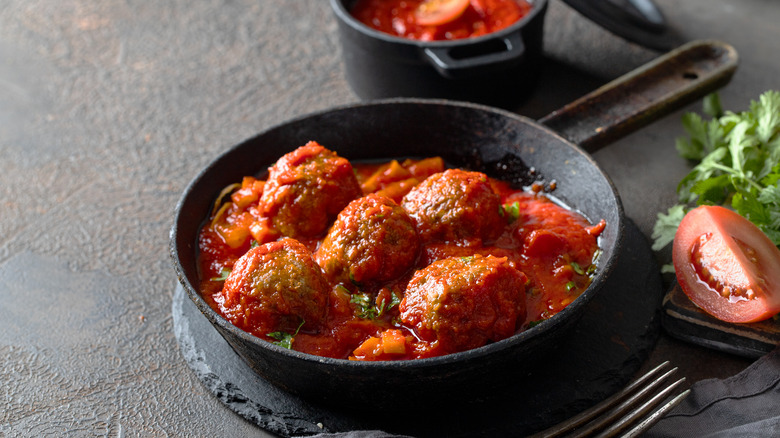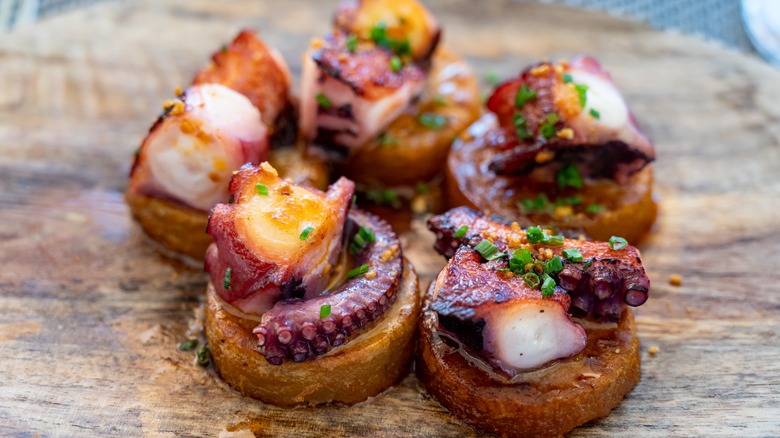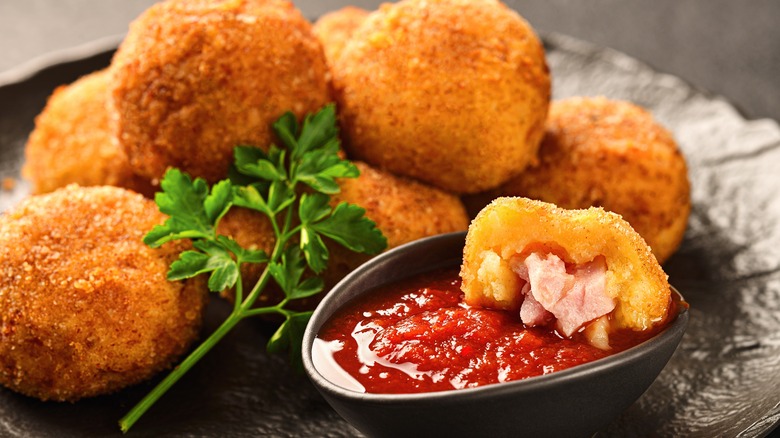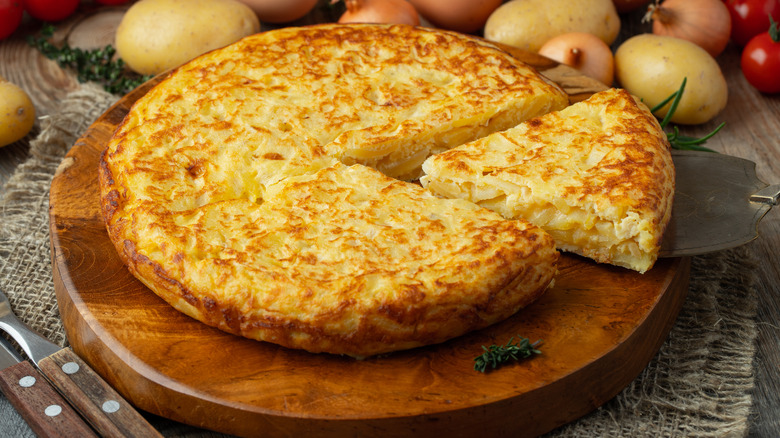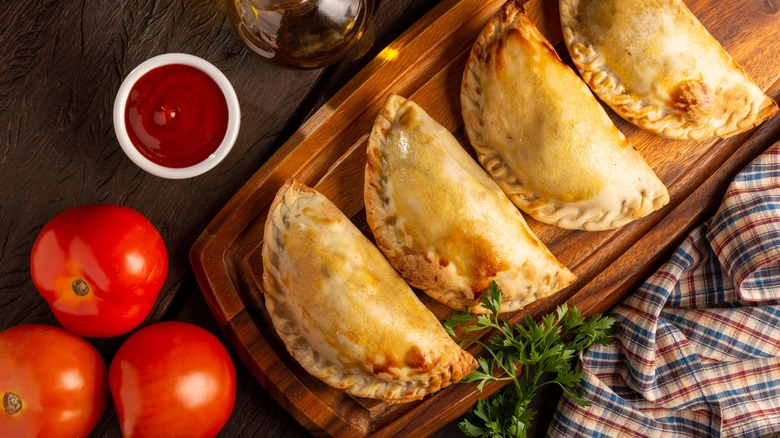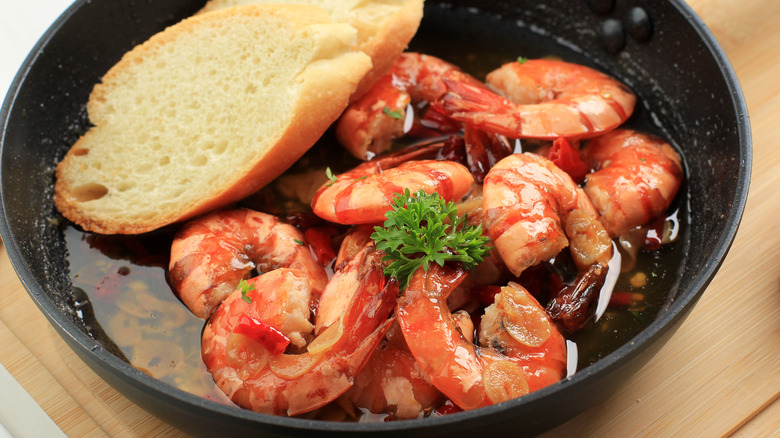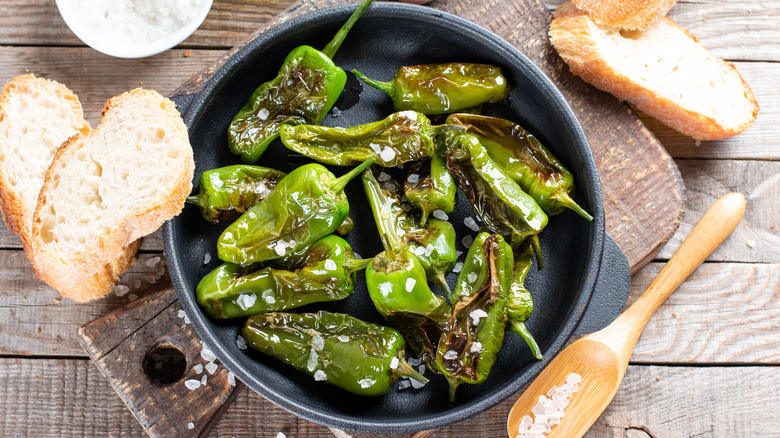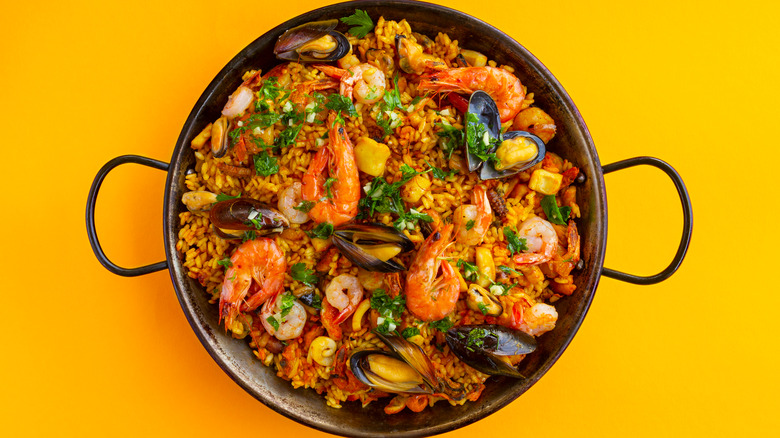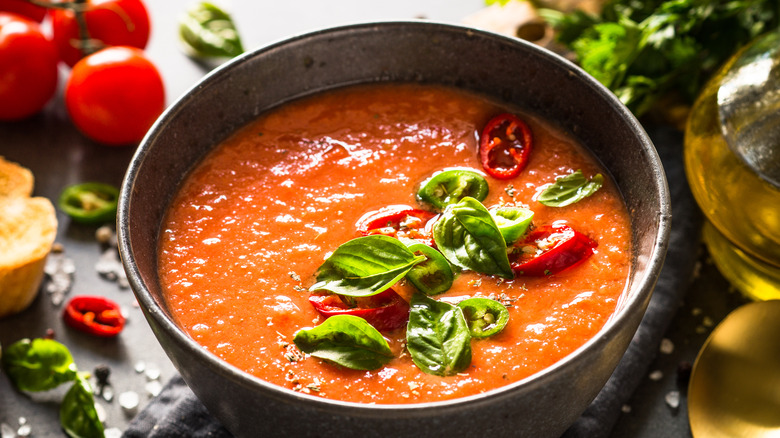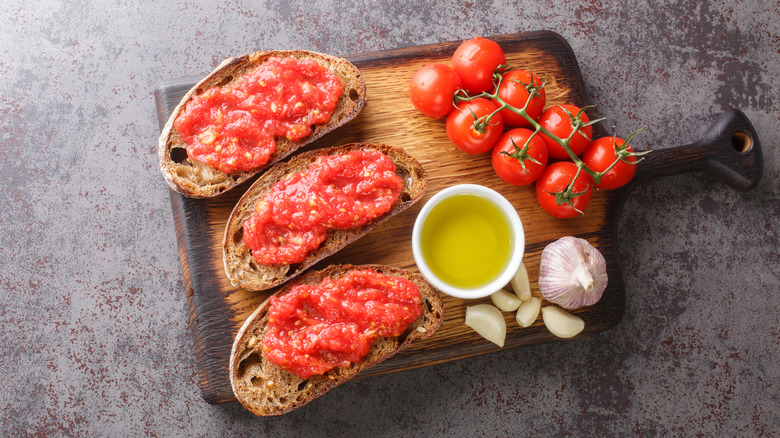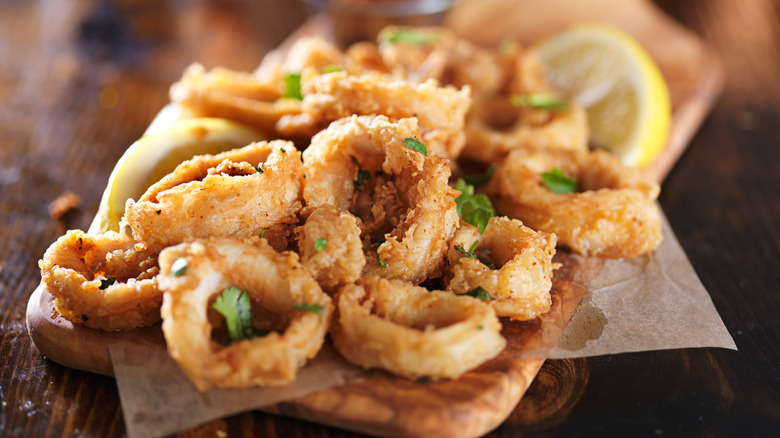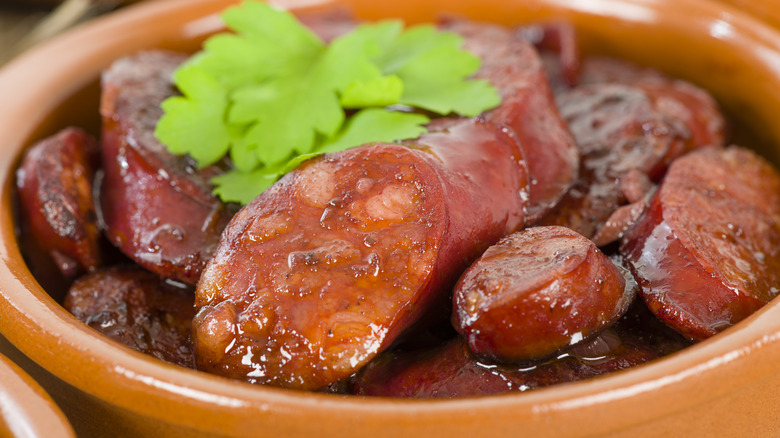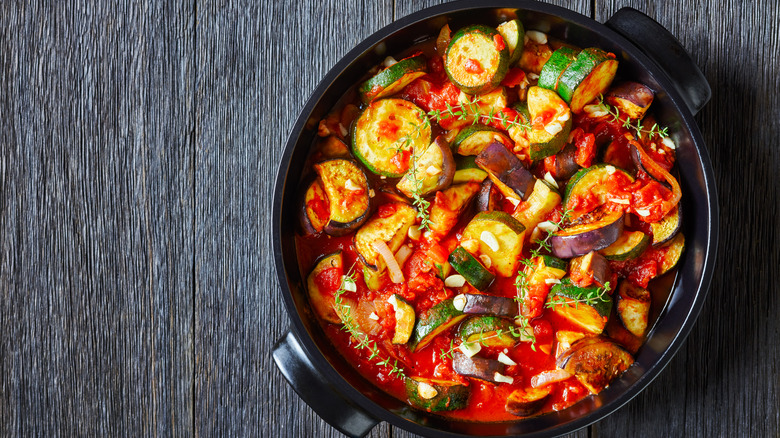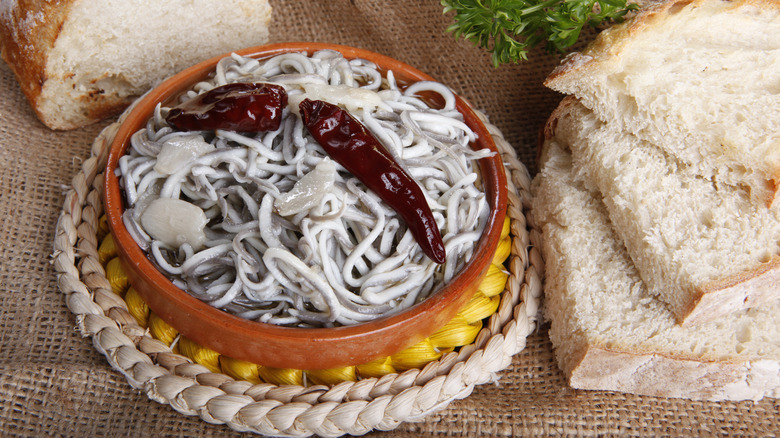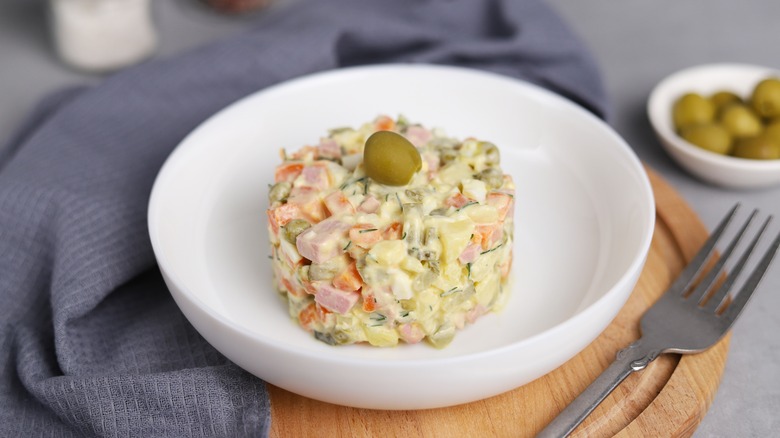Best And Worst Things To Order At A Tapas Restaurant
Tapas, small plates of tasty morsels for sharing, originated in Spain, where dinner is often served as late as 10 p.m. Friends meeting for drinks earlier in the evening order them as a snack to keep their stomachs padded. Since the word tapas stems from the verb "tapar" which means to cover, some explanations suggest they were first used as a way to keep flies out of drinks (via The Culture Trip). Serving small bites with drinks is a practice that has spread worldwide, and going out for tapas adds fun to any gathering thanks to the assortment of flavors and textures on the table. They also encourage conversation and let you try new and surprising dishes along with old favorites.
Tapping into the wonderful world of tapas can be a daunting prospect though. There are so many delicious dishes to choose from that it can take time to make up your mind. With selections ranging from simple plates of olives to more filling dishes with seafood, meat, cheeses, and vegetables, you might be uncertain about how much to order. Thankfully, the whole experience is quite relaxed, and most tapas restaurants leave the menu on the table so you can order all night long. Read on to learn which tapas are worth your money and which are better left untasted.
Best: Patatas bravas
Even if you've never been to a tapas restaurant, you may have heard of patatas bravas. One of Spain's most beloved snacks, these crisp and fluffy potatoes are typically served with a spicy tomato-based sauce and are perfect for sharing. Readily available, modestly priced, and a carbaholic's dream, this dish is flavorful and comforting all at once. Those new to tapas won't be intimidated, but their Spanish pedigree will please anyone looking to try authentic cuisine.
Despite the popularity of salsa brava, most Spanish chefs reserve it exclusively for patatas bravas, which may make tapas fans cherish it more. This classic dish translates to "fierce potatoes," and it's all about the sauce. Although ingredients vary around the country, vinegar and cayenne are commonly included, though some recipes omit tomatoes and rely on Spanish paprika for the vibrant red hue. Snack on them solo to load up on carbs or enjoy them alongside other small bites — just make sure patatas bravas hit the table.
Best: Albondigas
Albondigas (meatballs made with any combination of pork, beef, or lamb) were created in Spain but have since become popular in many Spanish-speaking countries. For instance, in Mexico, albondigas are most often found in soup. Meanwhile, at tapas bars, they're more likely to be simmered in a savory tomato sauce spiced with paprika, cumin, and cilantro, a hint of their Arabic influence.
The flavor combination is irresistible, and the delicious mix of tangy and slightly sweet notes makes it hard to stop at just one. They're bite-sized, just right for sharing with friends, and whether you're having a beer, sangria, or cocktails, albondigas pair up perfectly. Depending on the recipe, the texture of each bite can be deceptively complex. Some albondigas include bread crumbs, while others use rice, but the meatballs are always tender and juicy with added flavor thanks to the tomato sauce and spices.
Many tapas restaurants serve bread with albondigas, and you'll want to use it to mop up every drop of sauce. Traditionally, bread is served at every meal in Spain, so it's likely that you'll either have bread at the table or along with one or more of the dishes you order. Fair warning: Once you try albondigas, it's hard to stick with just one plate.
Best: Pulpo a la Gallega
We get it — octopus is a dish that might take getting used to, but if you love seafood, pulpo a la Gallega is a must-try. This traditional dish from Galicia, in the northwestern part of Spain, is made from boiled octopus seasoned with olive oil, paprika, and salt. It is traditionally arranged on a platter with boiled potatoes and bread, and since the Spanish believe that water should never be served with octopus, it's always served with red wine.
Although this dish is straightforward, it takes a careful chef to perfectly cook octopus. No one wants a rubbery texture, so tenderizing is a must, along with careful timing. Additionally, to prevent the octopus skin from sliding off in the cooking process, the traditional approach calls for dipping the octopus' head in boiling water before the final simmer. We think this level of commitment should be left to professionals.
Pulpo a la Gallega is sure to please all seafood lovers with its rich flavor and perfect amount of spice, so why not give it a try? Taste this quintessential Spanish delicacy the next time you're out for tapas; you might just discover a new favorite dish.
Best: Croquetas de jamón
Croquettes are usually associated with French cuisine, but they are beloved worldwide. A great option to use up leftovers, croquettes combine meat, vegetables, potatoes, and cheese into a mixture that is breaded and fried. In Spain, these fried morsels are called croquetas, and though you can find them with various fillings, croquetas de jamón are the most popular at tapas bars.
These indulgent bites are satisfying and delicious, with a crispy exterior that gives way to a creamy center. Croquetas de jamón are made with béchamel, a luxurious white sauce made with butter, flour, and milk. The sauce gives it a creamy decadence that makes us want to eat croqueta after croqueta. Its velvety smooth consistency highlights the taste of the salty ham, making this the perfect appetizer. This tasty creation puts ordinary croquettes with a potato base to shame.
If the idea of a ham croquette makes you shrug, the other big surprise a croqueta offers is that it's not made with just any old ham you'd order on a deli sandwich or carve up for Easter dinner. Instead, Serrano ham comes from the hindquarters of white pigs and is dry-cured for a minimum of seven and up to 16 months. The next time you order tapas, try this Spanish delicacy to transport yourself to Barcelona without a passport.
Best: Tortilla Española
Tortilla Española (also called tortilla de patatas) is a Spanish omelet made with potatoes and onions and served in practically every tapas restaurant. In Spain, the eggs are often left runny, and depending on the chef, it's cut into wedges or served atop a slice of crusty bread. Whether you eat it hot, at room temperature, or even cold, it's a delicious way to snack like the Spaniards.
Tortilla Española is similar to an Italian frittata, which may be more familiar to some diners. Still, where frittata recipes differ on potato prep (shredded, diced, or sliced), a tortilla always calls for sliced potatoes and is made on the stovetop instead of being finished in the oven like a frittata. While a traditional tortilla is a simple omelet of potatoes and onions, some tapas restaurants get creative and jazz it up, adding chorizo, octopus, goat cheese, or vegetables.
Scholars aren't clear on when the tortilla Española was first created, and records of omelets in Spain date back to 1519. However, there is disagreement about whether the specific recipe with potatoes and onions originated in 1817 or if it dates back as early as 1604. Still, the world knows about them now, and the consensus is that the tortilla Española is undoubtedly a winner at tapas restaurants.
Best: Empanadas
People love savory hand pies; practically every cuisine fills pastry pockets with meat, vegetables, sauces, and seafood, jazzed up with regional herbs and spices. Spanish empanadas began as a family-style sharing dish cut in wedges, but as other countries adopted the idea, they evolved into individual pies served as portable meals. Typically, empanadas are made with a basic flour and butter pastry dough, though some regions in Spain use corn flour or lard. Whichever pastry recipe is used, empanadas are delectable.
Ordering empanadas at a tapas restaurant is an absolute must. Grab one while you can because these deliciously savory treats will fly off the plate. Empanadas can be spicy, and while some have a saucy sofrito filling made with garlic, onion, peppers, olive oil, and smoked paprika, others just focus on meat. Aside from assorted meat add-ins like chicken, beef, pork, chorizo, or tuna, some empanadas also include olives, greens, or potatoes.
Regardless of which type of empanadas your table orders, there's something to satisfy every craving. Order a few options and pair them with a pitcher of sangria — you'll feel like you've been transported to Spain without ever leaving your seat.
Best: Gambas al ajillo
You'll want to try gambas al ajillo at a tapas restaurant if you're a seafood lover. This is the Spanish equivalent of an Italian scampi dish — shrimp, garlic, and chili sauteed in olive oil. Be sure not to miss a drop of the garlicky sauce, which consists of caramelized garlic bits in olive oil with a subtle kick of chili. Many tapas restaurants serve gambas al ajillo with crusty bread, but if they don't, you'll want to order it on the side.
In addition to its delicious taste, gambas al ajillo is good for you. To be clear, we aren't suggesting counting calories and grams of fat while enjoying an evening of great food and conversation, but shrimp is a solid choice for a healthy diet. Per Food & Nutrition, it's super high in protein while being low-calorie and containing almost no fat. It's no secret that olive oil is heart-healthy, and garlic is loaded with antioxidants, boosts immunity, and can help regulate blood pressure, according to Cleveland Clinic. Compared to other tapas, this one packs a nutritional punch.
Going out for tapas means trying as many enticing bites as possible, and gambas al ajillo won't fill you up — unless you're the only person soaking up the rich sauce with bread. This light, tasty dish offers authentic exquisite flavor and is a great match with cocktails — don't miss it.
Best: Pimientos de Padrón
Pimientos de Padrón is a simple dish consisting of small green chili peppers fried in olive oil and sprinkled with sea salt. In Galicia, they're the hottest bar snack around during pepper season from May to October. They are now grown worldwide and can be found on tapas menus everywhere. They're great to nosh on since they're low-calorie and are one of few vegan tapas options. Padrón peppers mostly consist of water so they are low calorie but also offer various vitamins and minerals (via Agroponiente).
The spiciness of chili peppers is expressed as ranges on the Scoville scale. Padrón peppers are very mild, measuring 0 to 3,000 Scoville Heat Units (SHU) (via Foodwise). To put it into perspective, jalapeño peppers range from 2,500 to 8,000 SHU. Spicier Padróns have a bite that pairs perfectly with cocktails and milder tapas like croquetas.
However, these innocuous chilis have a surprise in store. Although chili peppers have individual variations in spice level (for example, based on ripeness and where they were grown, Padrón peppers like to throw a curve. Many Padróns are no spicier than a bell pepper — until you get a rogue. It won't make you gasp for air or send you to the ER as a Carolina reaper pepper might, but the right group of diners could turn a plate of pimientos into an amusing drinking game.
Worst: Paella
Paella is a classic Spanish dish and it's delectable. Originating in Valencia, it was shared directly from the pot by local peasants working the land and made with ingredients fresh from the field (at that time, the dish didn't include seafood). So why would we tell you not to order it at a tapas restaurant?
Restaurants specialize in perfecting signature dishes; that's one reason people love going out to eat. Paella is a time-consuming dish that calls for care at each step. Unfortunately, most tapas restaurants have too much going on to concentrate their focus on paella. As one of Spain's quintessential dishes, paella deserves far more than a salty, greasy, dry, or overcooked version. To compensate, a tapas restaurant might overload the paella with every ingredient under the sun, substitute cheaper ingredients (such as turmeric instead of saffron), or make other missteps that will turn the dish from perfect to pitiful.
Whereas paella is meant to be eaten communally right from the pan, tapas are intended to be small bites. With its combination of rice, meat, and seafood, paella is a hearty, filling dish that goes against the idea of tasting an array of offerings, and it can be messy to boot. Nothing will stop the flow of conversation in its tracks faster than rice spilling in your lap or a saucy stain on your clothes. Do yourself a favor and stick to the traditional small plates at a tapas restaurant.
Worst: Gazpacho
Gazpacho, the classic cold soup, is a favorite Spanish specialty. The star of this summery refresher are tomatoes, along with bell pepper, onion, garlic, and cucumber. Vinegar, olive oil, water, salt, and pepper augment the flavors, and cooks might add spicy chilis, citrus, fresh herbs, and avocados.
The cold soup has always been customizable; not only have ingredients varied based on what's growing in the garden, but gazpacho's earliest iteration was a staple of Roman soldiers' rations. This earliest recipe included bread and didn't have tomatoes until Columbus brought them back from South America. In modern-day North America, we equate gazpacho with tomatoes, but other regions of Spain serve different varieties. White gazpacho, made with garlic, pine nuts, and fruit, is a southeastern specialty, while in the southwestern part of Spain, green gazpacho is freshened with herbs, peppers, endive, and lettuce.
We recommend avoiding it when you go out for tapas for the simple matter of getting the most bang for your buck. Given gazpacho's popularity, even those who have never gone out for tapas have probably tried it. In addition, it's so easy to make at home that paying for a shot glass of cold soup leaves us feeling frosty. For our money, tapas are all about trying new flavors and tasting authentic Spanish cuisine. Try something unique and save gazpacho for your bumper garden crops.
Worst: Pan con tomate
Pan con tomate is universally adored in Spain. It's so beloved in Barcelona that some waiters will look twice if you don't order it with your meal. It's simple to make: Rub grilled bread with garlic, then squeeze half a tomato over the surface to let the juices and pulp soak into the slice. Then, drizzle it with olive oil, sprinkle it with salt, and devour.
Pan con tomate is eaten as a snack, at tapas bars, for lunch, as a light supper, as the base of a sandwich, and even for breakfast. A variation of pan con tomate adds an anchovy filet on top, but this recipe is as simple as it gets. Here's the thing — please don't order it. There are so many other delicious options available at tapas restaurants to tantalize your taste buds, so why bother paying for a plate of toast with tomato?
When you need something quick and easy or have stale bread in need of revival, you can make your own pan con tomate. When going out for tapas with friends, filling your plate with delicious options and unique dishes is part of the experience. Take a chance and taste something new; that's what tapas are all about.
Worst: Calamari
Calamari is often associated with Italian cuisine but it is also eaten in significant quantities in Spain. It's no wonder since Spain is almost surrounded by water: the Mediterranean Sea, the Atlantic Ocean, and the Bay of Biscay. Calamari consists of batter-fried rings of squid cut from the body rather than the tentacles. It's an easy way to avoid getting the willies over eating squid since the snack looks like little onion rings.
We recommend skipping calamari because, quite honestly, they're no different from calamari you'd get anywhere else. If you're out for tapas to try authentic Spanish cuisine, you can argue that calamari fits the bill, but why not go for something unique that you can't get at the Olive Garden? Also, considering that eating deep-fried foods on the regular adversely affects heart health (via Harvard Health) and that poorly made calamari is akin to chewing on a tire, it seems to us that giving this one a pass is a no-brainer.
If however, your tapas menu reads "calamares a la Andaluza," you're in for a different treat: tiny, whole squid that are breaded and fried. These will make the squid-avoidant among your party cringe, so if you love to be seen as adventurous and shocking, go ahead and order these babies.
Worst: Chorizo al vino
Chorizo al vino is another tapa enjoyed in Spain. It's an uncomplicated dish consisting of sliced chorizo sausage braised in red wine, garlic, and bay leaves with crusty bread to soak up the broth. It's easy to confuse Spanish and Mexican chorizo if you haven't tried both. The main differences come down to how they're spiced and prepared. Spanish chorizo is a cured, salami-adjacent sausage flavored with garlic and Spanish smoked paprika, while Mexican chorizo is fresh and spicier with chilis and vinegar.
This dish is undoubtedly tasty, but we still don't recommend ordering it at a tapas restaurant. It ranks high on the list of disaster-prone dishes — imagine that red wine sauce all over your clothes and the tablecloth. It's also heavy and greasy, which goes against the idea of sampling an array of dazzling options. There are so many tapas to try and only so much room in your belly, so making deliberate choices is the key to the best dining experience.
Finally, chorizo al vino is an effortless recipe you can make at home, as long as you can find Spanish chorizo. All you have to do is brown the sausage with garlic in olive oil, add red wine, and let it reduce. A good loaf of bread and a salad will turn this into a Spanish meal you can be proud of — and if you drop sauce on your shirt, nobody will see.
Worst: Pisto
Pisto is a traditional stew similar to ratatouille in France; tomatoes, onions, red peppers, garlic, and eggplant are sauteed in olive oil until the combination creates a rich sauce. The vegetables might vary from kitchen to kitchen, based on regional preferences, and what is in season. Meanwhile, different spices and toppings like fried Manchego cheese or eggs make this dish further customizable and a great option to accompany meat, fish, or pasta.
We're all about a healthy diet, and everyone should eat plenty of vegetables. However, although we love pisto's nutritional profile and its unassuming yet complex taste, we don't consider it the best for tapas. Tapas are all about delicious small plates and coming together with your fellow diners. Pisto's stew-like consistency is messy for sharing and better suited to individual entrees.
Additionally, while some places might have mastered their version of this traditional Spanish dish, pisto is labor-intensive leading to shortcuts made from a pre-packaged mix with minimal flavor or authenticity. Instead, order pisto as a main course, or try your hand at making this satisfying stew at home.
Worst: Angulas al ajillo
Angulas al ajillo sounds pretty classy when you're reading the menu, but when the dish arrives at the table, you'll wish you'd translated the name. Angulas is the Spanish word for eels and in this case baby eels. Although baby eels in garlic sauce are a classic Spanish tapa, many Americans would swallow hard at the sight of a crock of tiny white wriggly-looking creatures.
Even if you can get past this dish's looks, the taste could very well leave you cold. Head chef at Madrid's Arima, Rodrigo García Fonseca, says of the slippery critters, "They have no taste, no color, nothing. A lettuce has more aroma ... but who doesn't like being a snob from time to time?" Considering baby eels cost thousands per pound, taste like nothing, and look frightful, it doesn't sound like the time to exercise your inner Kardashian.
Another big reason to give angulas al ajillo a pass is environmental. Angulas used to be a peasant dish in Spain, but as the demand for baby eels skyrocketed and they gained fame, they became endangered (via European Commission). Eels have a role in the ecosystem and their imminent extinction has unintended consequences. A black market trade has sprung up in response, with smuggling operations and eels from unregulated Chinese aquaculture farms often served to consumers. Angulas al ajillo are not worth the conservation hassle, the potential health hazards, or the money. Do yourself a favor and order something else.
Worst: Ensaladilla Rusa
Ensaladilla Rusa is potato salad with peas, carrots, and mayonnaise, and individual chefs might add beets, eggs, shrimp, tuna, or ham. Spain adopted the dish but it originated in Moscow (hence Rusa) in 1860. A Belgian chef, Lucien Olivier, is credited with creating it at the Hermitage Restaurant. His version for the wealthy clientele included pricey ingredients such as venison, caviar, and pheasant; as the recipe varied it became an everyday meal.
A big question about whether this salad is worth anyone's time revolves around its preparation. If you're at an unfamiliar tapas restaurant, ordering ensaladilla could be a mistake. Cutting corners with frozen peas and carrots could result in mushy, tasteless vegetables, which is not something diners seek out. Mayonnaise is another sticking point; most restaurants use industrial-sized jars, but homemade mayo differentiates between authentic ensaladilla and any old potato salad. It isn't worth it unless you know your tapas chef is dedicated to perfecting each ingredient.
Ensaladilla Rusa is a favorite at tapas bars throughout Spain, but we recommend skipping it. Our favorite tapas dishes are small, shareable bites that are easy to eat with little risk of getting food in our laps. This potato salad has the potential to have everyone blotting shirts and sharing Tide pens. Honestly, potato salad with peas and carrots just isn't that appealing. Ensaladilla Rusa at a barbecue sounds right, but as a shareable plate, it leaves us asking why.


